Common menu bar links
SATISFACTION WITH SERVICE DELIVERY CHANNELS
This section explores client perceptions of and satisfaction with the different service channels used to contact Service Canada during the previous six months. In order to limit response burden, respondents that had used multiple channels in their dealings with Service Canada (i.e. phone, in-person, Internet, etc.) were only asked about service related to one channel, selected at random (except for 1-800 O’Canada callers – see below).
Telephone Service
Respondents who received phone service were asked about the service received through either the 1-800 O’Canada phone line or other federal government phone lines. Only clients from among those included on the client list as having called 1-800 O’Canada and who acknowledged this in the survey were asked about the 1-800 O’Canada service. All others were asked about Service Canada phone service in general.
1-800 O’Canada (N = 416):
Reasons for Calling 1-800 O’Canada
Respondents who called 1-800 O’Canada to obtain information or service did so primarily to obtain information about a specific government program or service (42%). This was followed, at a distance, by calls to obtain general information (16%), program application information (15%), a government form (11%), information or clarification about benefits received (8%), and to update information (6%) (multiple responses accepted). Smaller numbers (5% or less) called to obtain a government publication, inquire about the status of an application, discuss the outcome of an application, or submit an EI claim report.
Q37: Earlier you mentioned that you had called Service Canada to obtain information or service. What was the purpose of the call(s)?
Widespread Satisfaction with 1-800 O’Canada
The vast majority of clients who called 1-800 O’Canada expressed satisfaction with the overall quality of service received. In total, 92% expressed satisfaction, with nearly three- quarters (74%) expressing strong satisfaction. Very few (3%) expressed any degree of dissatisfaction. Respondents were asked to use a 5-point scale (5 = very satisfied; 1 = very dissatisfied)
Those few clients who expressed dissatisfaction with the overall quality of service received (n = 12) said they were unable to get the information they needed when asked to explain their dissatisfaction. This included general information, information about online services, or information related to EI, OAS, or CPP.
Q41: How satisfied were you with the overall quality of service you received during your phone call(s) to Service Canada in the last six months? Please use a 5-point scale, where 1 is very dissatisfied, and 5 is very satisfied.
Positive Perceptions of 1-800 O’Canada Telephone Service
Positive feedback on specific aspects of 1-800 O’Canada service was also widespread and strong. Using another 5-point scale (5 = strongly agree; 1 = strongly disagree), clients who called 1-800 O’Canada were asked to express their level of agreement with the following service-related statements:
-
The government telephone number was easy to find.
-
You were able to get through to an agent without difficulty.
-
You were able to get the information you needed.
There was widespread and similar agreement with each of these statements (87-90%), with over two-thirds (69-75%) expressing strong agreement. Relatively few (4-7%) expressed disagreement with any of these statements.
Q38-40: Please tell me how much you agree or disagree with the following statements about your phone call(s) to Service Canada during the last six months, using a 5-point scale where 1 is strongly disagree, 5 is strongly agree. If something does not apply to you, please just say so.
Other Phone Service (N = 1,254):
Reasons for Calling Service Canada
Respondents who contacted Service Canada by phone to obtain information or service, but who did not use 1-800 O’Canada (or at least it is uncertain which phone line[s] were used) did so primarily to obtain information about a government program or service (33%), followed by program application information (20%). Other reasons cited with some frequency included submitting an EI claim (13%) and getting information/clarification on benefits received (12%). Identical proportions (7% each) called to obtain a government form, update information, or to inquire about the status of an application. Smaller numbers (5% or less) called to obtain general information, to learn about the outcome of an application, for information related to an appeal, to discuss the status of an appeal or its outcome, and to obtain a government publication.
Q37: Earlier you mentioned that you had called Service Canada to obtain information or service. What was the purpose of the call(s)?
Over Three-Quarters Satisfied with Telephone Service
Over three-quarters of those who called Service Canada expressed either strong (49%) or moderate (29%) satisfaction with the overall quality of service received. Among those who did not express satisfaction, 12% were neither satisfied nor dissatisfied, and 8% were dissatisfied.
Among those who expressed dissatisfaction with the quality of service they received (N = 105), the two reasons cited most often to explain why were getting bounced around (26%) and problems with the automated voice system (23%) (multiple responses accepted). That said, inability to get information of one kind or another was identified by nearly half (47%) the respondents. This included inability to get information about EI (14%), information in general (13%), CPP information (7%), information about online services (5%), information on updating personal information (4%), SIN information (3%), or OAS information (1%). Some (5%) were unable to submit an EI claims report. Included in the ‘other’ category are language barriers, having to call regarding a problem that was supposed to be resolved, and unclear responses/explanations.
Q41: How satisfied were you with the overall quality of service you received during your phone call(s) to Service Canada in the last six months? Please use a 5-point scale, where 1 is very dissatisfied, and 5 is very dissatisfied?
Q42: Why were you not satisfied with the quality of service you received?
Perceptions of Service Canada Telephone Service
As was the case with 1-800 O’Canada callers, clients who called Service Canada using some other phone line were asked to express their level of agreement with the following service-related statements:
-
The government telephone number was easy to find.
-
You were able to get through to an agent without difficulty.
-
You were able to get the information you needed.
While a majority offered positive assessments in each of these areas, the size of the majority varied. A substantial number (81%) agreed that they were able to get the information they needed, followed by almost three-quarters who felt the government phone number was easy to find (74%). Respondents were least likely to agree that they were able to get through to an agent without difficulty (60%). One in five disagreed with this, while 17% neither agreed nor disagreed. Disagreement with the other two statements ranged from 9-12%.
Q38-40: Please tell me how much you agree or disagree with the following statements about your phone call(s) to Service Canada during the last six months, using a 5-point scale where 1 is strongly disagree, 5 is strongly agree. If something does not apply to you, please just say so.
Q41: How satisfied were you with the overall quality of service you received during your phone call(s) to Service Canada in the last six months? Please use a 5-point scale, where 1 is very dissatisfied, and 5 is very dissatisfied?
Internet Service (N = 733)
Reasons for Visiting Government Website(s)
Clients who visited one or more Government of Canada websites to obtain information or service did so primarily to obtain information about a government program or service (43%). Less than half this number (20%) visited to view/obtain information on EI benefits (multiple responses accepted). Also mentioned relatively frequently were use of job ads or the Job Bank (12%), submitting an EI claimant report or applying for EI (10% each), and obtaining a government form (8%).
A number of reasons were identified by small numbers (4% or less). These included obtaining contact information, obtaining information on Service Canada programs, updating information, viewing their CPP Statement of Contributions, updating personal information using VUPI, submitting a CPP/OAS application, viewing a CPP/OAS/EI tax slip, or obtaining a government publication. Included in the ‘other’ category are applying for a day care subsidy, to access travel advisories, to complete an online survey, to print off passport information, and in order to get information more quickly.
Q43: Earlier you mentioned that you had visited one or more Government of Canada websites to obtain information or service. What was the purpose of your website visit(s)?
Most Visited Service Canada Website
A majority of those who visited federal government websites (54%) said they specifically visited Service Canada’s website. Most of the rest did not visit the Service Canada website (29%). As well, 17% are uncertain about the site(s) they visited.
For the remaining questions on the Internet channel, those who visited the Service Canada website were asked specifically about it, while those who did not or who were unsure were asked generally about Government of Canada website(s) visited during the previous six months for information or service related to the program/services explored in the survey.
Over Three-Quarters Satisfied with Internet Service
Almost identical numbers of clients who used the Internet, regardless of the site they used, expressed satisfaction with the overall quality of service received. Using a 5-point scale (5 = very satisfied; 1 = very dissatisfied), 78-79% expressed satisfaction with the overall quality of service. However, while the levels of satisfaction were almost identical, the intensity or degree of satisfaction differed. Users of the Service Canada website were far more likely to express strong satisfaction (49% vs. 37%).
Q44: Did you specifically visit the Service Canada website during the past six months?
Q48: How satisfied were you with the overall quality of the service you received through the Internet during the last six months? Please use a 5-point scale, where 1 is very dissatisfied, and 5 is very satisfied.
Among those who expressed dissatisfaction with the overall quality of service received through the Internet, users of the Service Canada website were more likely to identify problems with the website (59% vs. 41%), and to cite inability to apply for EI (16% vs. 6%). Respondents, regardless of the site used, were similarly likely to cite inability to obtain EI information (15-18%) and inability to update personal information (15-17%) as reasons for their dissatisfaction. Caution should be exercised when interpreting these results due to the very small sample sizes (n = 20-23).
Perceptions of Internet Service
Respondents who used Internet service were asked to express their level of agreement with the following service-related statements:
-
It was easy to find what you were looking for.
-
The site was visually appealing.
-
The site had the information you needed.
Clients, regardless of the site(s) used, expressed similar levels of agreement with each of these statements. They were most likely to agree that the site(s) they visited had the information they needed (80-83%), though users of the Service Canada website were more likely to strongly agree with this (53% vs. 43%). Smaller majorities agreed with the remaining statements. While users of the Service Canada website were slightly less likely to agree that the site is visually appealing (66% vs. 70%), they were more likely to strongly agree with this (35% vs. 28%). Almost equal numbers agreed that it was easy to find what they were looking for (66-68%).
Q45-47: Please tell me how much you agree or disagree with the following statements about the Service Canada website (Government of Canada website(s) you visited in the last six months), using a 5-point scale where 1 is strongly disagree, 5 is strongly agree. If something does not apply to you, please just say so.
Office/In-Person Service (N = 1,015)
Reasons for Visiting Service Canada Office
Clients who visited a Service Canada office to obtain information or service did so mainly to apply a government program (27%) or to apply for a Social Insurance Number (22%) (multiple responses accepted). This was followed by visits to obtain program information (16%), obtain a government form (9%), apply for a passport (8%), and submit EI claimant reports (6%). Smaller numbers visited an office for a variety of reasons, including completion of paperwork, information/clarification on benefits, updating information, inquiring about the status of an application, use of job ads or Job Bank, CPP/OAS-related matters, employment training, to discuss the outcome of an application, and attend an EI group session. Included in the ‘other’ category are renewing a SIN card, following up on a complaint, applying for a marriage certificate, and in order to deal with someone in person.
Q50: Earlier you mentioned that you had visited a Service Canada office to obtain information or service. What was the purpose of the visit(s)?
Widespread Satisfaction with In-Person Service
In total, 86% of those who visited a Service Canada office expressed satisfaction with the overall quality of service received, with over half (57%) expressing strong satisfaction. Very few (4%) expressed any degree of dissatisfaction with the service received.
Those who did express dissatisfaction with the overall quality of service (n = 36) were most likely to say they encountered problems with service staff (59%). Other problems included the inability to get EI information (15%), SIN information (9%), and to update personal information (1%). Caution should be exercized when interpreting these results due to the small sample size. Included in the ‘other’ category are dissatisfaction with result of encounter, the time it took to be served, and lack of clarity in information provided.
Q56: How satisfied were you with the overall quality of service you received at the Service Canada office in the last six months? Please use a 5-point scale, where 1 is very dissatisfied, and 5 is very satisfied.
Q57: Why were you not satisfied with the quality of service you received?
Positive Perceptions of In-Person Service
Positive feedback on specific aspects of phone service was also relatively widespread and strong. Using a 5-point scale, clients who visited a Service Canada office were asked to express their level of agreement with the following:
-
You waited a reasonable amount of time before getting service.
-
If you had an appointment, you were seen on time.
-
You were able to get the information you needed.
-
The hours of service were convenient.
More than three-quarters expressed agreement with all but one of these statements, with surveyed clients much more likely to express strong than moderate agreement with each of them. They were most likely to agree that they were able to get the information they needed (90%). Smaller, though still substantial majorities agreed that hours of service were convenient (80%) and that they waited a reasonable amount of time before getting service (77%). Although fewer than half (41%) agreed that if they had an appointment, they were seen on time, almost half (48%) said this did not apply to them (i.e. they did not make an appointment). Of those who did have an appointment, 79% expressed satisfaction that they were seen on time.
Relatively small numbers expressed disagreement with any of these statements (2-10%).
Q51-54: Please tell me how much you agree or disagree with the following statements about your visit(s) to the office, using a 5-point scale where 1 is strongly disagree, 5 is strongly agree. If something does not apply to you, please just say so.
Late Openings Preferred to Early Openings for Extended Hours of Service
Clients who disagreed that the hours of service were convenient (N = 77) were asked to choose from among three extended-hour options. Nearly two-thirds (63%) said that extending hours in the evening, 4:00 p.m. to 8:00 p.m., was most convenient for them. Most of the rest (31%) said Saturday morning opening was most convenient for them (9:00 a.m. to noon). Few (3%) preferred early morning, weekday openings (7:30 to 8:00 a.m.).
Caution should be exercised when interpreting these results due to the small sample size.
Q55: Which of the following extended hours would be most convenient for you?
Mail/Fax Service (N = 374)
Reasons for Using Mail or Fax Service
Clients who used regular mail or fax to obtain information or service did so mainly to apply for a government program (47%), followed at a distance by a desire to obtain information about how to apply for a government program (17%). The only other reasons identified with any frequency were to update personal information (9%) or obtain information or clarification about benefits (7%). A host of reasons were identified by small numbers (4% or less), including inquiring about the status of an application, submitting EI claimant reports, filing an appeal, getting general information, inquiring about CPP Disability, applying for a passport, discussing an appeal, obtaining labour market information, and obtaining information about filing an appeal. Included in the ‘other’ category are registering a complaint, acting as a proxy for someone else, and applying for a birth certificate.
Q58: Earlier you mentioned that you used the regular mail or fax to obtain information or service from Service Canada. What was the purpose of your mail or fax contact with the government?
Over Three-Quarters Satisfied with Service Received
Over three-quarters of those who used mail or fax (79%) expressed satisfaction with the overall quality of service they received. Moreover, over half were very satisfied. Among those who did not express satisfaction, 10% were neither satisfied nor dissatisfied, while 7% were dissatisfied.
Clients who expressed dissatisfaction with the overall quality of service (n = 24) were most likely to identify response time as the reason for their dissatisfaction. Other reasons related to the inability to get information, including information about SIN, CPP, OAS, EI, and online services. A few said they were unable to update personal information.
Q59: How satisfied were you with the overall quality of service you received in terms of your contact with Service Canada by mail or fax? Please use a same 5-point scale, where 1 is very dissatisfied, and 5 is very satisfied.
Email Service (n = 154)
Reasons for Using Email
Respondents who used email to obtain information or service did so mainly to locate specific information (24%), get information on applying for benefits (21%), or to get general information (19%). The only other reasons identified with any frequency were to apply online (10%) or check on the status of an application (9%). Small numbers used email to get a government form, get help with a Service Canada online service or help logging onto one, lodge a complaint, find a Service Canada Centre, and find out about Personal Access Codes.
Q61: Earlier you mentioned that you used email to obtain information or service from Service Canada. What was the purpose of your email correspondence with the government?
Email Addresses Obtained Mainly From Website Contact Page
Almost half of those who used email to obtain information/service obtained the email address they used from a contact page on a web 8%). Also cited were obtaining the address via a personal contact (18%), mail correspondence (9%), a phone inquiry (8%), through a brochure (6%), a search engine (4%) or an ad (1%).
Most Satisfied with Overall Quality of Email Service
The large majority of those who used email (81%) expressed satisfaction with the overall quality of service received. Only 4% expressed dissatisfaction.
Those who expressed dissatisfaction with the quality of service received (n = 9) focused on the response (or lack of response) to their email. This included receiving no response to their email(s), receiving a response that did not answer their question, receiving an inaccurate response, or waiting a long time for a response.
Q62: Where did you get the email address from?
Q63: How satisfied were you with the overall quality of service you received when using email with Service Canada? Please use a same 5-point scale, where 1 is very dissatisfied, and 5 is very satisfied.
Widespread Satisfaction with Service Received Through All Channels
The following graph presents the satisfaction levels for each of the service channels used (i.e. summarizes in one place the satisfaction scores that have been presented earlier in this report). Satisfaction with all of the channels was relatively widespread, with 78% or more expressing satisfaction with each channel. Satisfaction was highest for 1-800 O’Canada (92%) and in-person service (86%), and lowest for the two more ‘generic’ channels – other government websites (i.e. not Service Canada site) and other phone services (i.e. not 1-800 O’Canada), at 78% each.
Q41,48,56,59,63: How satisfied were you with the overall quality of service you received during [insert service channel] to Service Canada in the last six months? Please use a 5-point scale, where 1 is very dissatisfied, and 5 is very satisfied.
[ previous | table of contents | next ]

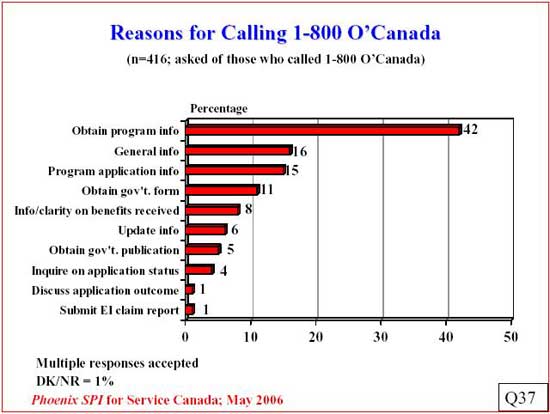 D
D D
D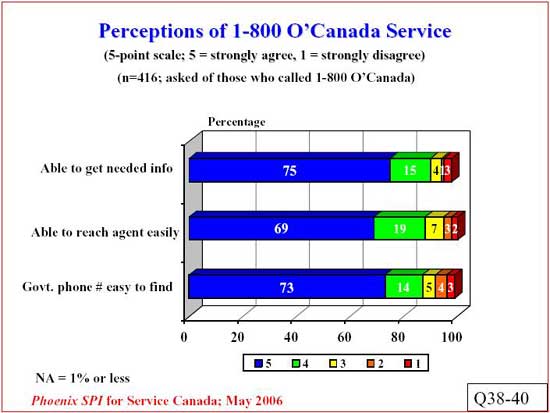 D
D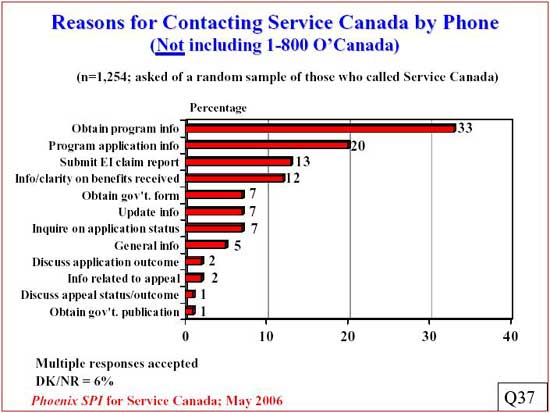 D
D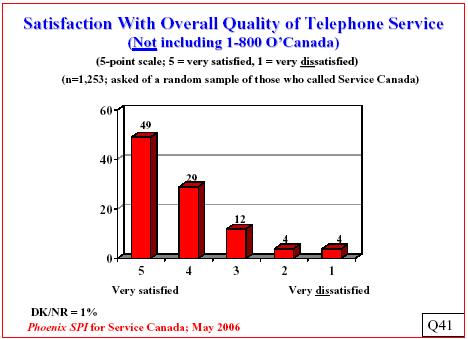 D
D D
D D
D D
D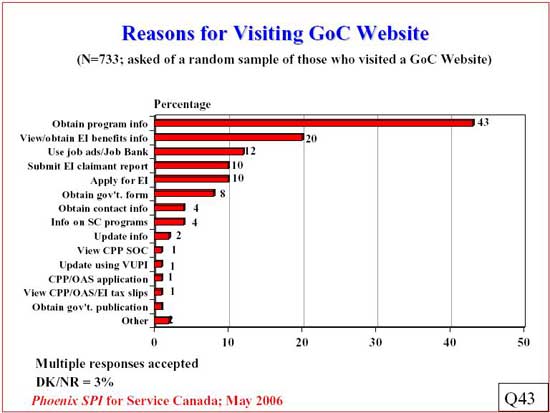 D
D D
D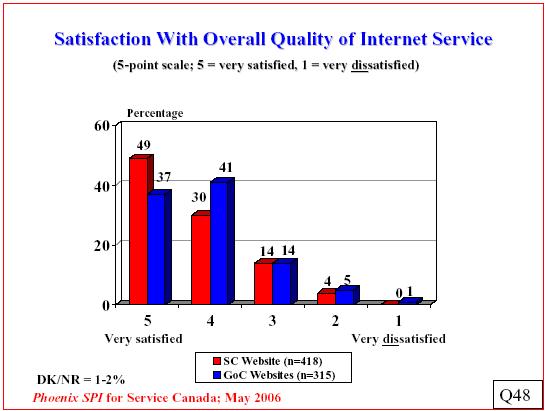 D
D D
D D
D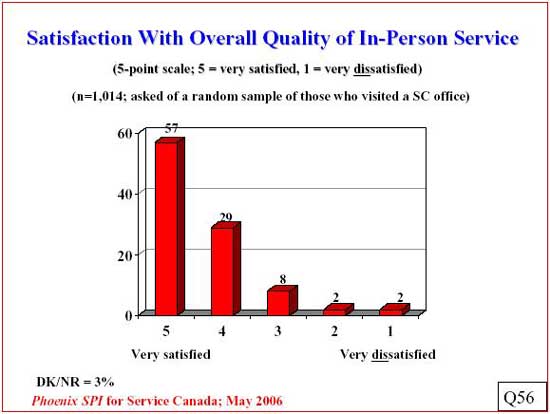 D
D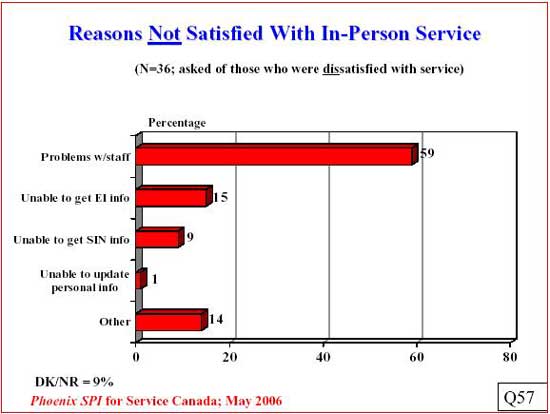 D
D D
D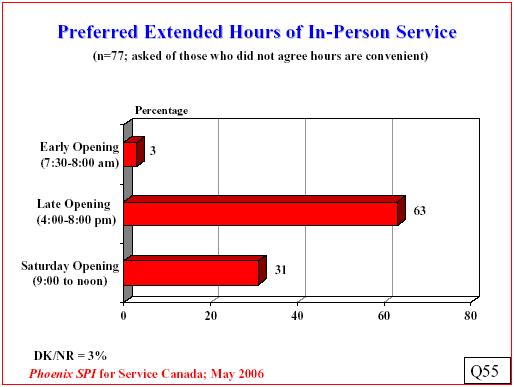 D
D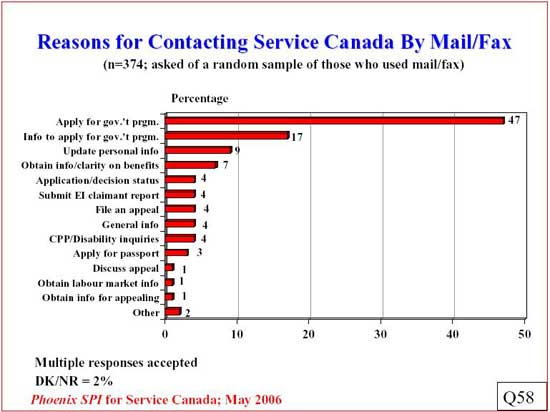 D
D D
D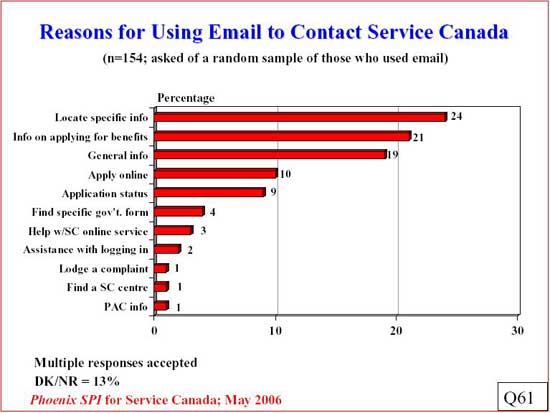 D
D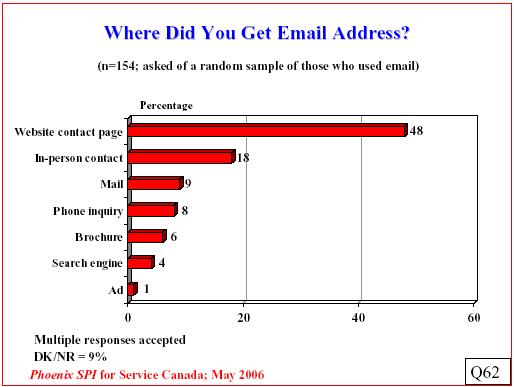 D
D D
D D
D